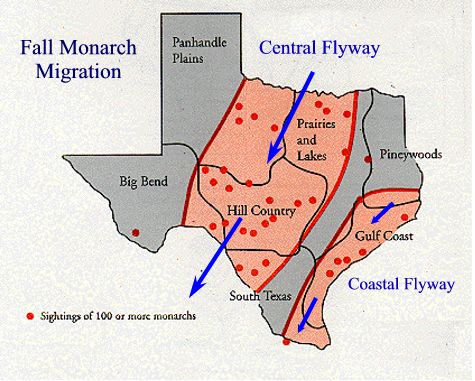The week was surprisingly quiet. After spectacular sightings to the north since August, why has the migration been so slow so far in central Texas? Are the monarchs still coming or have they slipped by? Also this week: Read true stories about tagged monarch butterflies, and explore what tagging can reveal about monarchs and their amazing journeys.
This Week's Update Includes:
- News: A Suprisingly Quiet Week...
- Nonfiction Reading:
- Hola Desde Mexico: Hello from Mexico
- The Migration: Maps and Journal Page
 |
What tales can a tagged monarch tell? Photo: Barbara Spence |
Expectations have been high for a big show in Texas, given the high numbers of monarchs reported in the north—and the fact that all monarchs headed to Mexico must cross that state. The monarchs move in two flyways across Texas, a "Central Flyway" and a "Coastal Flyway." (See map.) Here's the news:
Texas Central Flyway
After the big push into Texas from October 1-3, the past week seemed slow with just 10 new roost sites reported. If Ms. Branham's observations in Big Spring, Texas, indicate what's happening across the Texas central flyway, we wonder: Have the first monarchs already moved on? Is another big wave coming?
Notice how clearly the Big Spring monarchs moved out on Monday:
"The first wave arrived on October 3rd and they seemed to reach their maximum population from October 8-10. We had thousands. This picture was taken Sunday evening (Oct. 10th) at around 7 PM when the temperature was in the low 80s. A cool front was predicted to arrive very early Monday morning with low temperatures in the upper 40s to low 50s. A moderate northeast wind started up around midnight on Sunday night. On Monday morning, when I went outside at 8 AM, there was not a monarch in sight. Apparently they left in advance of the front."
Cooper High School observers saw a similar pattern:
"Had an ever so slight cold front come through Sunday, October 10th. Just enough northerly wind to get monarchs up and moving on Monday, Oct. 11. Just saw a few on Monday afternoon."
Texas Coastal Flyway
The migration typically moves along the Coastal Flyway after the Central Flyway. Monarchs that travel along the coast could come from the Gulf states, and/or they could be blown to the coast from the Central Flyway. The Aschen family watches daily from Port Lavaca:
October 13: Port Lavaca, Texas
"The migration along the Coastal Flyway started almost a week ago and the numbers are slowly increasing...The big surge, all the way from Cape May, NJ, should get here between October 21st and 28th... we'll see!"
Clearly crossing the border into Mexico!
Late this week came these reports from the US/Mexico border:
October 12: Del Rio, Texas
"Hundreds sighted. Most of them flying very high, hundreds of feet in the air. Our town is 3 miles from the US/Mexican border."October 13: Del Rio, Texas
"Monarchs by the thousands over Amistad Reservoir. Beautiful!!!"
Northern Mexico: Late for the Date
People across northern Mexico report their monarch sightings to Rocio Treviño's migration tracking project, Correo Real. According to Señora Treviño's records, the monarchs are late. They traditionally arrive by Mexico's Columbus Day, October 12th. However, look what an observer reported on the 13th:
13 de octubre: Cuatro Ciénegas, Saltillo
"Conté 90 mariposas en 3 minutos."
Southeast
Three roosts, and many reports of peak migration,
in the Gulf coast states indicate large numbers of monarchs are passing through that region.
Fallout on the Virginia Coast
The week's most spectacular observation was a 'fallout' on the Virginia coast last Friday. A 'fallout' is said to occur when weather conditions shift suddenly during migration and make travel so difficult that the migrants seem to 'fall out' of the sky.
"In all my years here at Chincoteague, I had never seen a fallout of monarchs—until this afternoon," began Denise Gibbs. "Today in the interdune area, there may have been several hundred thousand monarchs. I walked one mile along the shore of Tom's Cove and still did not reach the end of the nectaring monarchs."
 |
| Texas Flyways |
 |
| How many monarchs in this Texas roost? Photo: Jaynie Branham |
|
 |
"Fallout" on Virginia Coast
|
Read true stories about tagged monarch butterflies. Explore what tagging recoveries reveal about monarchs and their amazing journeys. Each story provides a snapshot of migration, based on single monarchs that were tagged and recovered. |
"No monarchs yet," Estela Romero reports from Angangueo where she has been monitoring regularly.
This week, she also interviewed students while riding the bus to school. How does life in our town today compare to that 80 years ago, she asked the kids.
|
 |
 |
 |
For
Your Journal |
||
Seeing Monarchs? Please let us know!
|
||




